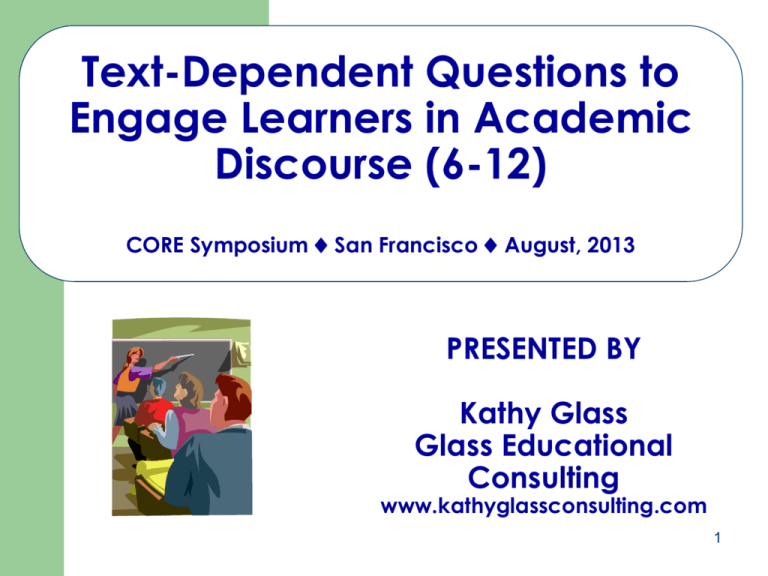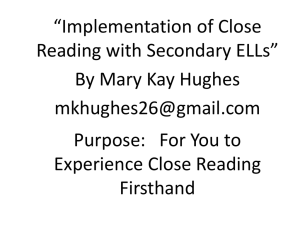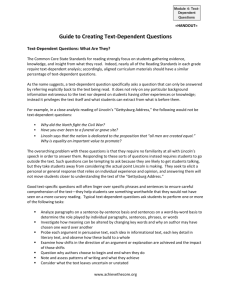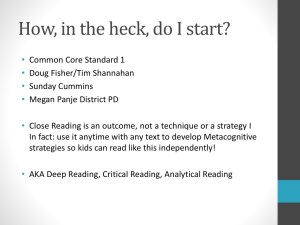What are text-dependent questions?
advertisement

Text-Dependent Questions to Engage Learners in Academic Discourse (6-12) CORE Symposium ♦ San Francisco ♦ August, 2013 PRESENTED BY Kathy Glass Glass Educational Consulting www.kathyglassconsulting.com 1 Agenda Build Use Text-Dependent Questions Text-Dependent Questions to Facilitate Instruction Around Complex Text “Eighty to ninety percent of the Reading Standards in each grade require text-dependent analysis; accordingly, aligned curriculum materials should have a similar percentage of text-dependent questions.” From Revised Publishers’ Criteria for the CCSS in ELA, Coleman and Pimentel Shifts in ELA CC Standards Building knowledge through contentrich nonfiction and informational texts Reading and writing grounded in evidence from the text Regular practice with complex text and its academic vocabulary Source: Adapted from Student Achievement Partners, 2011 What are text dependent questions? How do I craft them? 5 What are text-dependent questions? Designed around complex text that is fiction or nonfiction Prompts readers to use the text to respond Helps to facilitate close reading by compelling readers to examine and analyze the text to uncover rich meaning From Mapping and Designing Units to the ELA Common Core, 6-12 by Kathy Glass Not Text-Dependent Text-Dependent In “Casey at the Bat,” Casey What makes Casey’s strikes out. Describe a time when experiences at bat you failed at something. humorous? In “Letter from a Birmingham Jail,” Dr. King discusses nonviolent protest. Discuss, in writing, a time when you wanted to fight against something that you felt was unfair. What can you infer from King’s letter about the letter that he received? In “The Gettysburg Address” Lincoln says the nation is dedicated to the proposition that all men are created equal. Why is equality an important value to promote? “The Gettysburg Address” mentions the year 1776. According to Lincoln’s speech, why is this year significant to the events described in the speech? www.achievethecore.org Text-Dependent or Not? 1. 2. 3. 4. How does Babbitt use the Ferris wheel to describe a year or time? Use quotes from the prologue to support your response. What is it like to ride on a Ferris wheel? How does it feel to be at the very top? The author describes the cottage in Chapter 1 as having a “touch-me-not” appearance. Who might live here? Would this be a place you’d like to live or visit? How does the “touch-me-not” appearance of the cottage affect Tuck and other members of his family? Text: Tuck Everlasting by N. Babbitt www.kathyglassconsulting.com Designing TextDependent Questions Step 1: Develop essential understandings around the text Step 2: Identify what is noteworthy about the text Step 3: Create a final assessment Step 4: Target vocabulary, sentence syntax, and text structure Step 5: Recognize key details Step 6: Delve into challenging areas of the text Step 7: Arrange questions in appropriate order for instruction www.kathyglassconsulting.com ESSENTIAL UNDERSTANDINGS: What text might you use that addresses these? 1. People search for a place to call home and a sense of family to foster security. 2. Sometimes the truth needs to remain secret to protect people from harm. 3. Effective leaders can help unite disparate groups to achieve a unified goal by using compromise and strategy. 4. The structures and behaviors of living organisms help them adapt to their environments so they can survive. © Kathy Glass ▪ www.kathyglassconsulting.com 10 Concepts represent mental images, constructs, or word pictures that help people to arrange and classify fragmented and isolated facts and information. “Social Studies Overview” from The NY State Educational Department, Albany, NY Examples of Concepts Science Social Studies Literature Health Energy Evolution Genetics Gravity Light Patterns Systems Community Culture Diversity Economy Exploration Politics Religion Alienation Conflict Courage Maturation Power Prejudice Utopia Diet Disease Exercise Hygiene Illness Puberty Wellness © Kathy Glass ▪ www.kathyglassconsulting.com STEP 1: Create Essential Understandings 1. Read text. Read “Assume You’re Under Surveillance” by Andy Kessler on the next slide. 2. List concepts. Make a list of concepts that you glean from this article. 3. Brainstorm statements. Brainstorm a list of statements pertaining to this article using your concept list. You might need the frame: “From this reading, students will understand that...” © Kathy Glass ▪ www.kathyglassconsulting.com Essential understandings… are constructed in complete sentences. focus on at least two concepts. form a relationship between the concepts using strong verbs. have transfer value and prime students to make connections so no proper nouns or past tense verbs are used. (not always) represent what you really want students to understand about the text; answers the questions “why is this important?” or “how?” © Kathy Glass ▪ www.kathyglassconsulting.com Concepts Brainstorming Surveillance Governments are using technology to monitor Government people’s communication Security and location. Essential Understandings Governments utilize technology to protect people from crime which might infringe on privacy rights. People can select technology carefully to minimize government intrusion of their rights. Fear Skepticism Privacy Rights Crime There are positives and negatives to the privacy debate. Using surveillance is a way to protect people from crime. It is an injustice to monitor people in intrusive ways. People have an active role in how they are monitored. © Kathy Glass ▪ www.kathyglassconsulting.com Designing TextDependent Questions Step 1: Develop essential understandings around the text Step 2: Identify what is noteworthy about the text Step 3: Create a final assessment Step 4: Target vocabulary, sentence syntax, and text structure Step 5: Recognize key details Step 6: Delve into challenging areas of the text Step 7: Arrange questions in appropriate order for instruction www.kathyglassconsulting.com STEP 2: Identify What Is Noteworthy Writing style (e.g., repetition of sentence structure, phrases, or particular words) Passages that: – are ripe for making inferences – are difficult to read because of sentence syntax – are complicated because of figurative language (e.g., simile, metaphor, imagery) – have literary devices that are mature for the reader (e.g., dialect, flashbacks) – have difficult concepts that need interpretation – include challenging words © Kathy Glass ▪ www.kathyglassconsulting.com STEP 2 Examples Allusion: “It’s been over 60 years since George Orwell published 1984…” Imagery: “… the National Security Agency is building a massive, $2 billion data center in Utah capable of storing 5 zettabytes of data—the equivalent of ‘every email, cell phone call, Google search, and surveillance-camera video for a long time to come.’ ” www.kathyglassconsulting.com Mood: general feeling of the work; the emotions readers feel while reading; conveyed through dialogue, setting, plot, images. How do you feel as you read it? threatened, exposed “… the National Security Agency is building a massive, $2 billion data center in Utah capable of storing 5 zettabytes of data—the equivalent of ‘every email, cell phone call, Google search, and surveillance-camera video for a long time to come.’ ” www.kathyglassconsulting.com Designing TextDependent Questions Step 1: Develop essential understandings around the text Step 2: Identify what is noteworthy about the text Step 3: Create a final assessment Step 4: Target vocabulary, sentence syntax, and text structure Step 5: Recognize key details Step 6: Delve into challenging areas of the text Step 7: Arrange questions in appropriate order for instruction www.kathyglassconsulting.com Informative/Explanatory Essays Students use their research and their identification of patterns [emotion word “families”] to help them answer the following prompt: How do Douglass' feelings change over the course of this piece? What is Douglass trying to show about how slavery makes people feel? Write a paragraph in which you show how his feelings change and what you believe he is trying to show the reader. Douglass selection from www.achievethecore.org Informative/Explanatory Essays Students should write an adequately planned and well-constructed informative essay regarding the meaning of the essay’s title “Living Like Weasels.” Why has the author chosen this title? Why is it significance? Students should include at least three pieces of evidence from the text to support their thoughts. Dillard selection from www.achievethecore.org Informative/Explanatory Prompt After reading Sandra Cisneros’ excerpt of “Eleven,” write a short analytical essay explaining the narrator’s attitude toward turning eleven and the aging process. Remember To: • State your topic clearly in the introduction. • Include how Cisneros uses literary devices, sentence structure, and word choice to convey her message and point of view. • Cite evidence from the story to support your explanation. CORE Module Narrative For homework, choose one of the following prompts to complete: (1) Construct a narrative that teaches the same lesson(s) that Tom [Sawyer] learns at the end of the passage. Incorporate both the voice of a narrator, as well as dialogue in your story. (2) Write a parody of the scene by changing the characters and work being done to reflect a modern dilemma. www.achievethecore.org Opinion/Argument Language Arts: Opinion/Argument Read Emma Lazarus’ poem “The New Colossus.” Stake a claim about the theme of the text. Be prepared to orally defend your interpretations and judgments through evidence from the text. Write a persuasive letter from the point of view of a historical figure from a time in history to another historical figure. Focus your letter on how the situation should be handled using factual information from the text. From Mapping Comprehensive Units to the ELA Common Core K—5 by Kathy Glass Argument Prompt Arts: Opinion/Argument AfterLanguage reading “The Road Not Taken” by Robert Frost, write an argumentation essay in response to this prompt: What is the theme of the poem and how is it developed over the course of the poem’s four stanzas? Remember to: State your impression of the poem’s theme clearly. Support your position about the theme by including how Frost’s word choice, repetition, and structure convey his message. Cite evidence from the poem to support your analysis. Consider and address alternate themes from the poem. CORE Module TEMPLATE #2 for ARGUMENTATION/ANALYSIS [Insert a background statement that introduces the prompt or a question]: _______________. After reading ____________________________ (literature or informational texts), write a/an _____________ (essay, report, or substitute) that addresses the question and support your position with evidence from the text(s). Level (L) 2 Be sure to acknowledge competing views. L3 Give examples from past or current events or issues to illustrate and clarify your position. Literacy Design Collaborative www.literacydesigncollaborative.org TEMPLATE #12 for INFORMATIONAL OR EXPLANATORY/DEFINITION What is “metaphor”? After reading The House on Mango Street and drawing from other works you’ve read this year, write an essay that defines “metaphor” and explains how authors use it to enhance their writing. Support your discussion with evidence from the texts. Literacy Design Collaborative www.literacydesigncollaborative.org Designing TextDependent Questions Step 1: Develop essential understandings around the text Step 2: Identify what is noteworthy about the text Step 3: Create a final assessment Step 4: Target vocabulary, sentence syntax, and text structure Step 5: Recognize key details Step 6: Delve into challenging areas of the text Step 7: Arrange questions in appropriate order for instruction www.kathyglassconsulting.com Syntax The study of the rules for the formation of grammatical sentences in a language. The study of the patterns of formation of sentences and phrases from words. www.dictionary.com Text-Dependent Task Sentence Ask students to parse the syntax of the final sentence in the passage, paying careful attention to how the constituent parts of the sentence add up to create the unique meaning of Douglass’s words. The slave was made to say some very smart as well as impressive things in reply to his master—things which had the desired though unexpected effect; for the conversation resulted in the voluntary emancipation of the slave on the part of the master. www.achievethecore.org Text-Dependent Task Rewrite this sentence into your own words. What mood does it evoke? Sentence “It is a melancholy object to those who walk through the great town or travel in the country, when they see the streets, the roads, and cabin doors, crowded with beggars of the female-sex, following by three, four, or six children, all in rags and importuning every passenger for an alms.” (Swift, “A Modest Proposal”) www.kathyglassconsulting.com Divide this long sentence into individual sentences that explain its meaning. Change or delete words that do not contribute to the meaning: “The Earth's crust, on which we live and depend, is in large part the product of millions of once-active volcanoes and tremendous volumes of magma that did not erupt but instead cooled below the surface.” * We live and depend on the Earth’s crust. The Earth is the product of millions of volcanoes that were once active. The volcanoes leave magma that didn’t erupt but cooled below the surface. www.kathyglassconsulting.com * USGS science for a changing world Three Tiers of Words Tier One: everyday speech Tier Two: general academic words Tier Three: domain-specific words “Materials aligned with the CCSS should help students acquire knowledge of general academic vocabulary because these are the words that will help them access a wide range of complex texts.” Source: “Revised Publisher’s Criteria…” Tier Two words (general academic words) • appear in all sorts of texts: • informational texts (e.g., relative, vary, formulate, specificity, and accumulate) • technical texts (calibrate, itemize, periphery) • literary texts (misfortune, dignified, faltered, unabashedly) • often represent subtle or precise ways to say relatively simple things Appendix A, p. 33, slightly adapted 36 (Appendix A, p. 33) “Volcanoes” excerpt In early times, no one knew how volcanoes formed or why they spouted red-hot molten rock. In modern times, scientists began to study volcanoes. They still don’t know all the answers, but they know much about how a volcano works. Our planet made up of many layers of rock. The top layers of solid rock are called the crust. Deep beneath the crust is the mantle, where it is so hot that some rock melts. The melted, or molten, rock is called magma. Not so long ago in Montgomery, Alabama, the color of your skin determined where you could sit on a public bus. If you happened to be an African American, you had to sit in the back of the bus, even if there were empty seats up front. Back then, racial segregation was the rule throughout the American South. Strict laws—called “Jim Crow” laws—enforced a system of white supremacy that discriminated against blacks and kept them in their place as second-class citizens. People were separated by race from the moment they were born in segregated hospitals until the day they were buried in segregated cemeteries. Blacks and whites did not attend the same schools, worship in the same churches, eat in the same restaurants, sleep in the same hotels, drink from the same water fountains, or sit together in the same movie theaters. In Montgomery, it was against the law for a white person and a Negro to play checkers on public property or ride together in a taxi. (Appendix A, p. 34) Freedman, Russell. Freedom Walkers: The Story of the Montgomery Bus Boycott (2006) Most southern blacks were denied their right to vote. The biggest obstacle was the poll tax, a special tax that was required of all voters but was too costly for many blacks and for poor whites as well. Voters also had to pass a literacy test to prove that they could read, write, and understand the U.S. Constitution. These tests were often rigged to disqualify even highly educated blacks. Those who overcame the obstacles and insisted on registering as voters faced threats, harassment and even physical violence. As a result, African Americans in the South could not express their grievances in the voting booth, which for the most part, was closed to them. But there were other ways to protest, and one day a half century ago, the black citizens in Montgomery rose up in protest and united to demand their rights—by walking peacefully. It all started on a bus. (Appendix A, p. 34) Freedman, Russell. Freedom Walkers: The Story of the Montgomery Bus Boycott (2006) Step 4 Examples (Vocabulary) In the first stanza, Frost uses the word “diverged.” What does this mean, and what context clues can you pull from the text to support your assertion? Why does Frost repeat this in the final stanza? Explain the term “proposition” as it is used in this address. (“Gettysburg Address”) Paragraph one mentions “they,” although this reference to “they” is unclear. How does the speaker feel about “they”? What words in the passage show this feeling? (“Eleven”) CORE Modules Project Designing TextDependent Questions Step 1: Develop essential understandings around the text Step 2: Identify what is noteworthy about the text Step 3: Create a final assessment Step 4: Target vocabulary, sentence syntax, and text structure Step 5: Recognize key details Step 6: Delve into challenging areas of the text Step 7: Arrange questions in appropriate order for instruction STEP 5: Recognize Key Details Can be a combination of any of these types of questions: Foundational; can prepare for more sophisticated questions Literal; can be answered using direct words from the text Calls on readers to connect ideas or information from the text www.kathyglassconsulting.com Examples of Questions for Step 5 (Key Details) (Q1) Why is Douglass specific about making friends with “little white boys”? (Q2) How did Douglass learn how to read when running errands? (Q1) What features of a weasel’s existence make it wild? Make it violent? (Q2) What instances in the text show a display of weasels being “obedient to instinct”? www.achievethecore.org Designing TextDependent Questions Step 1: Develop essential understandings around the text Step 2: Identify what is noteworthy about the text Step 3: Create a final assessment Step 4: Target vocabulary, sentence syntax, and text structure Step 5: Recognize key details Step 6: Delve into challenging areas of the text Step 7: Arrange questions in appropriate order for instruction STEP 6: Delve into Challenging Areas of the Text Focus on Step 2 notated words and sections: – dense material and concepts – inferential opportunities – hard to interpret literary devices – complicated figurative language Possible overlap with Step 4 (syntax) if passages with challenging sentence structure have sophisticated content. www.kathyglassconsulting.com Step 6 Examples (Challenging Questions) In the last stanza, Frost reveals a certain tone. Identify the tone and record particular words that demonstrate it. Why does the narrator adopt this tone? Explain how the absence of figurative language affects the emotional tone of the address. What is the theme of “Road Not Taken”? What textual evidence supports it. What evidence in paragraph three shows that the speaker thinks it is acceptable and normal to act like a 3 year old even if you are all grown up? CORE Modules Project Generic Tailored to Text Why does the author Why does Dahl use irony? What use this literary device effect does it have on the reader? (hyperbole, allusion, dialect, etc.): _____? How do Anne Frank’s actions and What do characters’ decisions reveal about decisions define her character? themselves? How and why do our impressions of her change? What literary devices Cisneros uses the metaphors of does the author use? an onion, rings of a tree trunk, Provide an and stacking dolls to describe interpretation or growing old. Reread that rewrite the passage in paragraph and rewrite it in your your own words. own words. Mapping Comprehensive Units to the ELA Common Core Standards, 6-12 by K. Glass Designing TextDependent Questions Step 1: Develop essential understandings around the text Step 2: Identify what is noteworthy about the text Step 3: Create a final assessment Step 4: Target vocabulary, sentence syntax, and text structure Step 5: Recognize key details Step 6: Delve into challenging areas of the text Step 7: Arrange questions in appropriate order for instruction “The sequence of questions should not be random but should build toward more coherent understanding and analysis.” “An effective set of discussion questions might begin with relatively simple questions requiring attention to specific words, details, and arguments and then move on to explore the impact of those specifics on the text as a whole.” Source: “Revised Publisher’s Criteria…” How do teachers facilitate close reading of complex text? 50 Prepare for Close Reading Divide text into sections or passages. Underline words where there are no context clues; provide definitions in the margin or on a separate sheet of paper. Use bold to indicate Tier 2 words, or general academic words. Develop essential understandings of the whole text and text-dependent questions associated with each section of the text. www.kathyglassconsulting.com “Many students will need careful instruction — including effective scaffolding — to enable them to read at the level required by the CCSS. However, the scaffolding should not preempt or replace the text by translating its contents for students or telling students what they are going to learn in advance of reading or listening to the text; the scaffolding should not become an alternate, simpler source of information that diminishes the need for students to read or listen to the text itself carefully.” Source: “Revised Publisher’s Criteria…, K-2” Ideas for Introducing the Passage Avoid conducting prereading activities. Give brief definitions of words in which context clues do not reveal meanings. Set the stage for the lesson by posing an essential guiding question and stating the title and author. Prepare students for complexity. www.kathyglassconsulting.com Initial Exposure to Text: Option 1 Listen to text/record observations. Discuss with a partner and class. Read silently. www.kathyglassconsulting.com Initial Exposure to Text: Option 2 Read silently/record observations. Discuss with a partner and class. Listen to text. www.kathyglassconsulting.com IN DEPTH EXAMINATION: Answer Text-Dependent Questions and Perform Tasks Prompt students to reread text frequently and independently to address text-dependent questions and tasks. Students refer to evidence from the text when responding. Tasks can be varied and might include a combination of formal and informal responses. Use a variety of teaching methods. Use a variety of grouping configurations. www.kathyglassconsulting.com Grouping and Instructional Strategies Ideas* Individually Pairs or Trios Small Group Whole Class Think-Pair-Share Roundtable RAFT Games Cubing Graphic Organizers Jigsaw Reciprocal Teaching * Not a finite list www.kathyglassconsulting.com DIAMANTE How about other opposites? Bullies – Non-bullies Protagonist – Antagonist Summer – Winter One Culture – Different Culture Pilgrims – Native Americans Solids – Liquids Fiction – Nonfiction Angiosperms – Gymnosperms Rural – Urban Little Red Riding Hood – Wolf RAFT RAFT Role (What role should the student assume? From whose point of view is the piece written?) Audience (Who will read, see, or use this?) Format (What is the most effective and meaningful product format to show understanding?) Topic (What is the topic focus for the product?) 61 How can I focus on academic vocabulary and discourse? Role Teacher Teacher Teacher Teacher Audience Format Topic Self List words Tier 2 words in a reading selection; highlight those that don’t have context clues Students Letter What I promise you this year with regard to my focus on academic vocabulary and discourse Self and Lesson Academic discourse Colleagues Plan instructional strategies Parents Back to School handout Specific ways and resources to help students increase vocabulary © Kathy Glass kathytglass@yahoo.com CUBING DIE/CUBE PROMPT EXAMPLE include evidence from the text. From Mapping Comprehensive Units to the ELA Common Core by Kathy Glass Mapping Comprehensive Units to the ELA Common Core Standards by Kathy Glass, page 150 Roll the pair of dice. Write several questions based on the targeted text with the two words that face up, such as: How can …? When might …? Why is …? © Kathy Glass ▪ www.kathyglassconsulting.com CORE MODULES Resources Basal and Anthology Alignment Projects (Edmodo) Reading Like a Historian “Engaging the adolescent learner: text dependent questions” article by Fisher and Frey (online) Close Reading Exemplars: www.achievethecore.org Literacy Design Collaborative (LDC) Mapping Comprehensive Units to the ELA Common Core, K-5 and 6-12 by Kathy Glass (Corwin booth) © Kathy Glass ♦ kathytglass@yahoo.com Kathy Glass, Glass Educational Consulting 469 Eleanor Drive Woodside, CA 94062 Phone: 650-366-8122 E-mail: kathy@kathyglassconsulting.com Website: www.kathyglassconsulting.com Website: Downloadable resources: lessons, templates, PPts, Common Core Standards (Word) Join PD 360 group for periodic tips Archived webinars Information about PD topics and books 71



